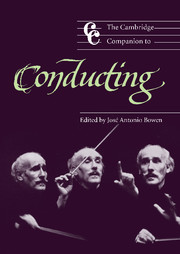Book contents
18 - Training conductors
from Part III - Issues
Published online by Cambridge University Press: 28 September 2011
Summary
Much present-day conductor training is moribund, weighted down by highly questionable tradition and surrounded by self-serving myths and misconceptions. The training of conductors remains virtually unchanged from the early days of the composer-conductor timekeepers who stood before their bands of players with a complete knowledge of the creative fabric of their own compositions, but without a stitch of conducting technique. Conductor training still concentrates on learning and understanding the music, at the expense of the technical expertise needed to convey this knowledge to the orchestra. No other component of the symphonic world has remained so resistant to change, so we continue to graduate nineteenth-century conductors in the twenty-first century. The entire subject of conductor training needs fresh ideas, open minds, and a willingness to create a rapport with a new technical proficiency based on the demands of the music.
Four factors have kept contemporary conductor training from embracing new techniques. (1) The separation of pulse and music, which first emerged in the divided leadership of the eighteenth century, has fostered the notion that the two are indeed separable. (2) Traditional beat patterns have been accepted as the sum of conducting technique. (3) The myth of the “born conductor” continues to subvert the new models of training; why bother with classes if charisma is the central ingredient? (4) The increasing virtuosity of the orchestra has made the job of the modern conductor easier; modern professionals are capable of playing much standard repertoire without any leadership at all.
- Type
- Chapter
- Information
- The Cambridge Companion to Conducting , pp. 249 - 261Publisher: Cambridge University PressPrint publication year: 2003
- 2
- Cited by



